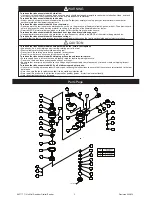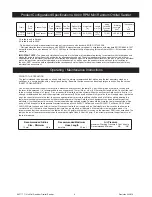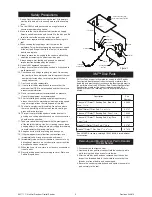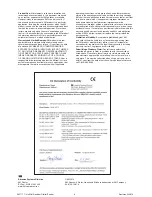
3M™ 1 1/4 in Mini Random Orbital Sander
5
Revision 040610
Safety Precautions
1. Read all instructions before using this tool. All operators
must be fully trained in its use and aware of these safety
rules.
2. The tool RPM should be checked on a regular basis to
ensure proper operating speed.
3. Make sure the tool is disconnected from the air supply.
Select a suitable abrasive and secure it to the disc pad. Be
careful to center the abrasive on the disc pad.
4. Always wear required safety equipment when using this
tool.
5. When sanding/buffing always start the tool on the
workpiece. This will prevent gouging due to excess speed
of the buff pad. Stop air flow to the tool as it is removed
from the workpiece.
6. Always remove the air supply to the sander before fitting,
adjusting or removing the abrasive or disc pad.
7. Always adopt a firm footing and grip and be aware of
torque reaction developed by the sander.
8. Use only 3M approved spare parts.
9. Always ensure the material being sanded is firmly fixed to
avoid movement.
10. Check hose and fittings regularly for wear. Do not carry
the tool by its hose; always be careful to prevent the tool
from being started when carrying the tool with the air
supply connected.
11. Dust can be highly combustible.
12. If tool is serviced or rebuilt check to ensure that the
maximum tool RPM is not exceeded and that there is no
excessive tool vibration.
13. Do not exceed maximum recommended air pressure.
Use safety equipment as recommended.
14. Prior to installing any sanding or polishing accessory,
always check that its marked maximum operating speed
is equal or higher than the rated speed of this tool.
15. The tool is not electrically insulated. Do not use where
there is a possibility of contact with live electricity, gas
pipes, and/or water pipes.
16. This tool is not protected against hazards inherent in
grinding and cutting operations and no such accessories
should ever be attached.
17. Take care to avoid entanglement with the moving parts
of the tool with clothing, ties, hair, cleaning rags or loose
hanging objects. If entangled, stop air supply immediately
to avoid contact with moving tool parts.
18. Keep hands clear of the spinning pad during use.
19. If the tool appears to malfunction, remove from use
immediately and arrange for service and repair.
20. Immediately release the start handle in the event of any
disruption of pressure; do not attempt to re-start until the
disruption has been corrected.
21. When tool is not in use, store in a clean dry environment
free of debris.
22. Recycle or dispose of tool according to Local, State, and
Federal Regulations.
Figure 1
Closed Loop Pipe System
Sloped in the direction of air flow
Drain Leg
Ball Valve
To Tool Station
Filter
Drain Valve
Regulator
Lubricator
Ball
Valve
Ball Valve
Air Flow
Air Dryer
Air Compressor
and Tank
Air Hose
To Coupler
at or near Tool
3M™ Disc Pads
3M Disc Pads are perfectly mated for use on the 3M Sander.
Constructed from premium, industrial-quality materials, their
durability and precise construction are the ideal complement to
the performance of the 3M Sander. See Product Configuration/
Specifications table for the correct replacement pad for a
particular model. The following chart is a sample of products
offered.
See 3M ASD Accessory catalog 61-5002-8098-9 for additional
Accessories.
1. Disconnect air line from sander.
2. Remove old disc pad from sander. Hold the sander spindle
while turning the disc pad counter clockwise.
3. After the old disc pad has been removed from the sander,
inspect the threaded hole in the spindle to ensure that the
threads are free of debris and undamaged.
4. Secure the sander spindle by hand and tighten the new disc
pad securely to the tool.
Removing and Mounting Disc Pad to Random
Orbital Sander
Description
Part
Number
Finesse-it™ Roloc™ Sanding Pad, Blue Vinyl
Face, 1
1
/
4
in.
02345
Stikit™ Roloc™ Disc Pad, 1
1
/
4
x
5
/
16
in.
02727
Finesse-it™ Roloc™ Sanding Pad, Firm, 1
1
/
4
in.
13442
Finesse-it™ Roloc™ Sanding Pad, Vinyl Face,
Firm,
1
1
/
4
in.
02511
Hookit™ II Roloc™ Disc Pad, 1
1
/
4
dia.
02787
Hookit™ Roloc™ Disc Pad, 1
1
/
16
x
5
/
16
in.
67415






